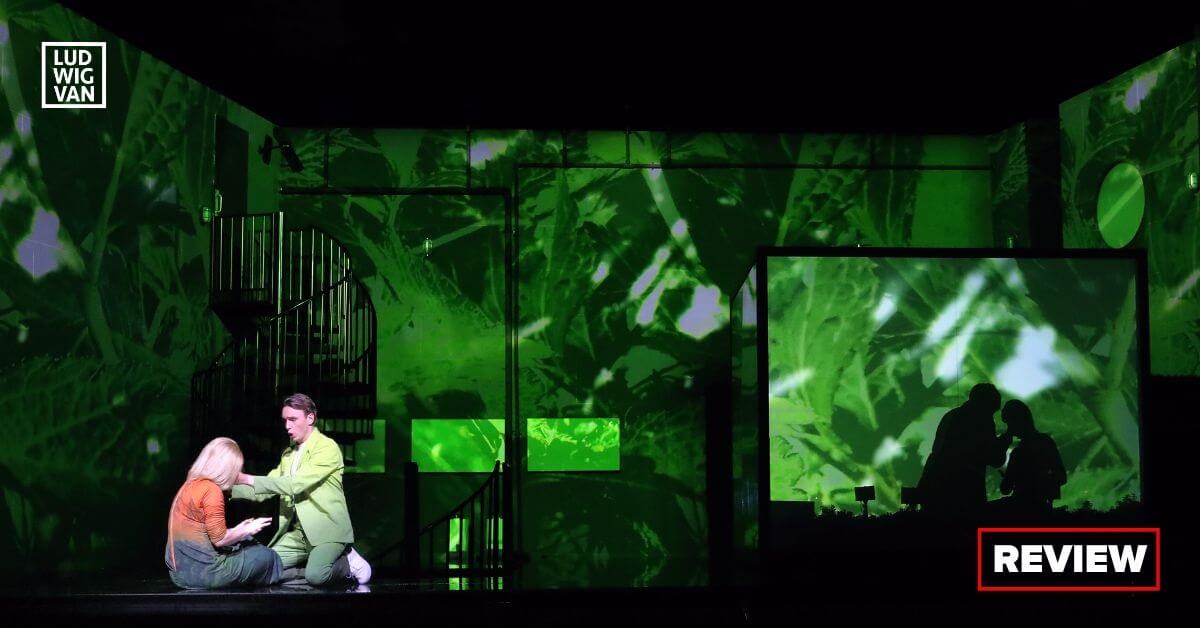
A major summer music festival in North America, the Santa Fe Opera has entertained opera lovers with glorious music since its inception in 1957 by the late American conductor John Crosby, who was at the helm until his retirement in 2000. He conducted his final performance, Richard Strauss’s Elektra, on August 24, 2000, a stunning 567th time on the Santa Fe Opera podium.
Crosby’s vision of opera in the desert is very much alive and thriving to this day. The 2023 marks its 66th season, with a felicitous mix of operas spanning three centuries — Orfeo (1607), The Flying Dutchman (1843), Tosca (1900), Rusalka (1901), and Pelleas et Melisande (1902). The only thing missing this year is a contemporary work, an in` formal tradition of the Santa Fe Opera. It’s good to know that it’ll resume next season with the world premiere of The Righteous by composer Gregory Spears, with Canadian conductor Jordan de Souza at the helm.
I have been coming to the “Land of Enchantment,” aka Santa Fe, since 1998. The artistic standards have always been very high, not to mention the bonus of enjoying the incredible mountain vista surrounding the opera house. I’ve been hooked ever since, returning many times in the last quarter century. My 2023 sojourn consisted of all five operas, beginning with The Flying Dutchman (July 31), followed by Tosca (August 1), Orfeo (August 2), Pelleas et Melisande (August 3), and Rusalka (August 4).
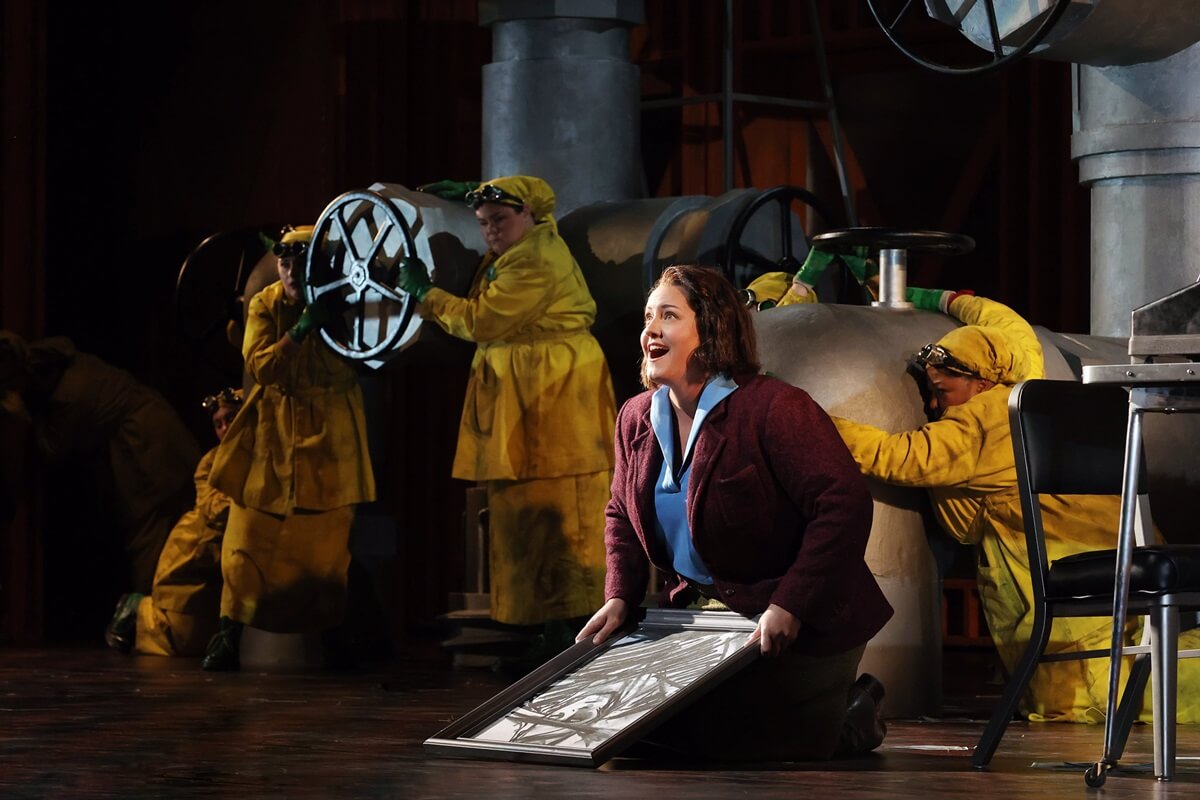
The Flying Dutchman
Wagner is a rarity at the Santa Fe Opera — last year’s Tristan und Isolde was its first in 34 years. To the delight of Wagner fans, Dutchman made it two years in a row, with an ideal cast starring South African Elza van den Heever as Senta and American bass-baritone Nicholas Brownlee as Dutchman. Van den Heever was a luminous Senta, singing with power, beauty, and a full palate of tone colours. Brownlee, last season’s memorable Kurwenal in Tristan, was an equally fine Dutchman. As Daland, Morris Robinson’s sonorous bass was impressive. Tenor Chad Shelton, a late replacement, was an excellent Erik, a rather thankless role. Former Apprentice tenor Bille Bruley was a fresh-voiced Steersman, while current Apprentice soprano Gretchen Krupp made a characterful Mary.
The production was another story altogether. British director David Alden’s concept was a bit of a head scratcher, one of the most non-nautical looking Dutchman sets (by designer Paul Steinberg) I have seen. Instead of spinning wheels, the women were costumed in garishly yellow factory uniforms, doing nondescript duties. At one point, Dutchman appeared in a three-piece business suit. The chorus, made up of SFO Apprentice singers, were musically fine, but the choreography reminded me more of Broadway than a Wagner opera. Thomas Guggeis conducted with energy and passion, exciting if a touch too loud.
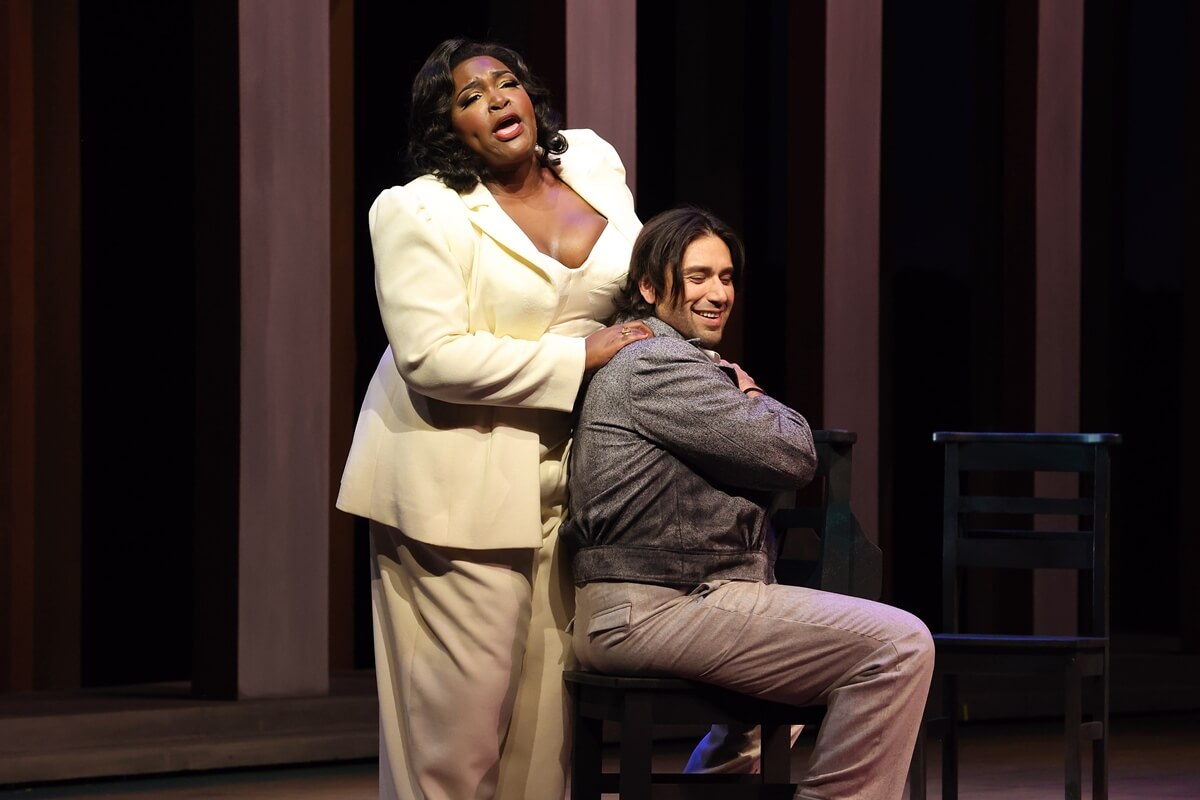
Tosca
The Wagner opera was followed by the Puccini warhorse, Tosca. Once again, singers with very fine voices. While it was sad that Angel Blue cancelled the whole run due to a family emergency, Leah Hawkins was a worthy replacement. Her Roman diva was marked by rich, sumptuous tone and suitably stately presence. Tenor Joshua Guerrero (Cavaradossi) matched her with a ringing tenor and great high notes. Baritone Reginald Smith Jr held his own as Scarpia. Yet I am sorry to say that it wasn’t as good as it should have been, due to the production, the staging and to a certain extent musically. I was expecting more from the American conductor John Fiore, who led a fine COC Un ballo in Maschera way back in 1989. His conducting here was marred by flaccid tempi, especially in Act One. Somehow, his conducting sounded rather routine to my ears.
The production was by another big-name director, Keith Warner. The set by Ashley Martin-Davis bears little resemblance to a church in Act One, to Scarpia’s study in Act Two, or Castel Sant’Angelo in Act Three. This was the first time I’ve seen a Tosca where the audience stare at the back of Cavaradossi’s painting of the Madonna. Why? It takes away a focal point of the drama. During the Act Two sexual assault scene, Tosca and Scarpia are several feet apart. Again, why? Rather than stabbing Scarpia, Tosca strangles him with a cord. Instead of jumping to her death, she points a gun to her own head as the stage light goes out, but no sound of gunshot. If I sound like I am nitpicking, so be it. I would love to hear the thoughts of Mr. Warner. To that end, it would have been great if the lavish program contained directors’ notes.
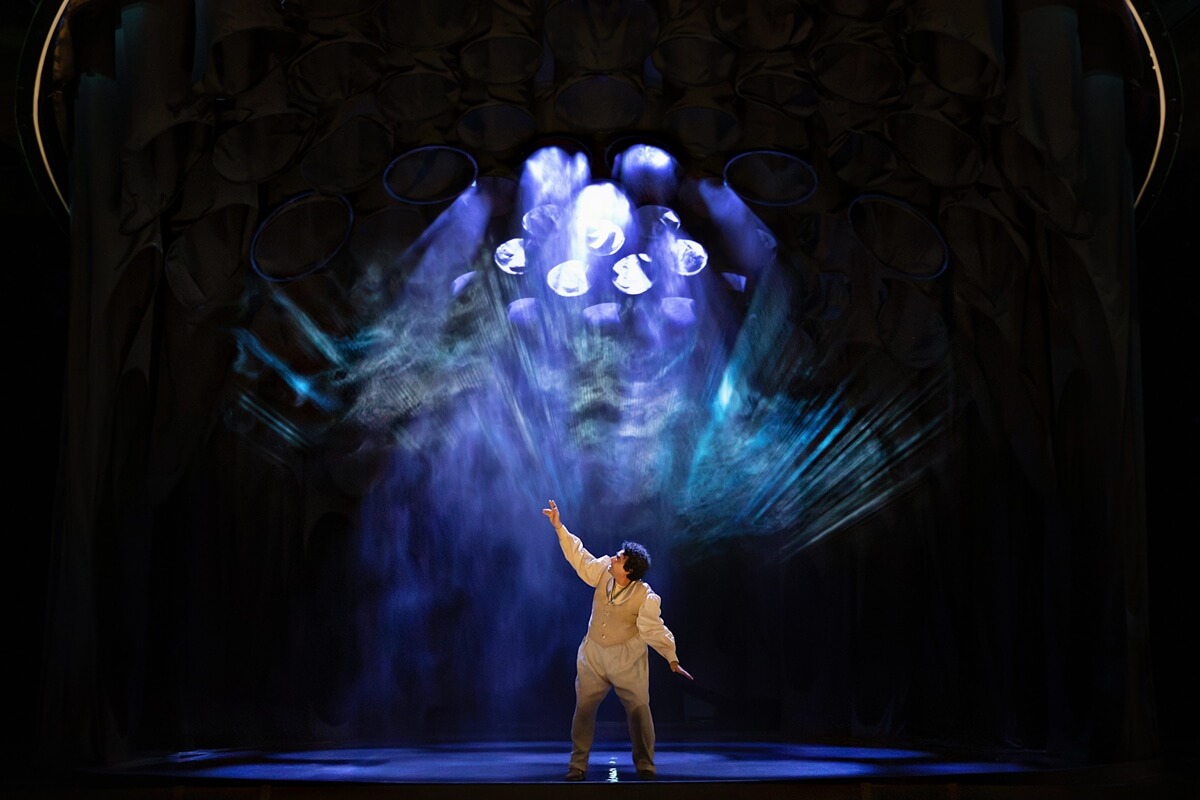
Orfeo
A major attraction of this 2023 Santa Fe season was the appearance of Rolando Villazon as Orfeo (August 2). I heard Villazon multiple times early in his career, but never in Baroque. His Orfeo almost didn’t happen, as he sustained a back injury while strapped in a harness suspended in midair at the final dress rehearsal. He had to cancel opening night (July 21). Fortunately, he was well enough — though I understand heavily medicated — to sing the performance I saw. Some of his aerial acrobatics had to be cut as a result.
The Yuval Sharon production dispenses with representational realism, instead we got a brilliantly imagined visual feast, starting with the descent of Orfeo into Hades to look for his beloved Euridice, sung by Amber Lorelai. The stage is dark, with Orfeo suspended in midair. In Euridice’s scene, she’s surrounded by extraterrestrial creatures dressed in black, with heads framed by circles of light, creating quite a spectacular visual effect. Orfeo is of course an opera seria, but somehow Sharon manages to inject a few brief moments of humour, likely to showcase the irrepressible stage persona of Villazon.
Given that the Monteverdi Orfeo is written for a baritone, it would seem unsuited to Villazon the tenor. But time and overuse have robbed him of his vocal brilliance, especially in the high register, making Orfeo a good compromise given his current vocal estate. Together with his trademark heart-on-sleeve acting, he had a success, a few awkward vocal moments notwithstanding. Also noteworthy was the La Musica of soprano Lauren Snouffer and the La Messaggera of mezzo Paula Murrihy. SFO Music Director Harry Bicket, an Early Music specialist, led a striking performance of the newly re-orchestrated score for modern instruments by Nico Muhly, specially commissioned by Santa Fe Opera for this run.
Pelleas et Mélisande
My fourth opera, Pelleas et Mélisande (August 3), was last staged at Santa Fe Opera a long 46 years ago. It’s a piece one either loves or hates. It had the largest number of empty seats of the five operas I saw, a real shame. Given the excellence of the performance, put me in the “love” camp! Top vocal honours go to the two lovers. Pelleas is written for a baryton Martin, an ideal role for British lyric baritone Huw Montague Rendall. The high tessitura, with its G-sharps in Act 4, did not faze him in the least. Dramatically, he fully embodied the character. He was well partnered by mezzo Samantha Hankey, whose Mélisande was sung with gorgeous, gleaming tone, perhaps a touch too powerful as one is used to a softer, more vulnerable heroine.
The supporting roles were ably taken, especially the Golaud of Zachary Nelson, one of the best I’ve encountered. Susan Graham took on the relatively small role of Genevieve, singing strongly if with somewhat diminished vocal gleam. Incidentally, her costume was ultra glamourous, inexplicably so. Veteran bass Raymond Aceto made a welcome return to SFO and brought the requisite gravitas to the role of Arkel. Harry Bicket led the orchestra in a refined reading of the score.
As productions go, this one by Netia Jones has its share of idiosyncrasies. To my eyes, the powerful colour scheme used are somehow at odds with the Impressionistic flavour of the work. Call me a stickler for representational details — Mélisande’s short hair really does not go with the text. While I am at it — what are the doppelgangers of the three principals supposed to signify? I could go on, but I think I’ll stop here. Once again, I wish there were director’s notes
in the program to enlighten the audience members.
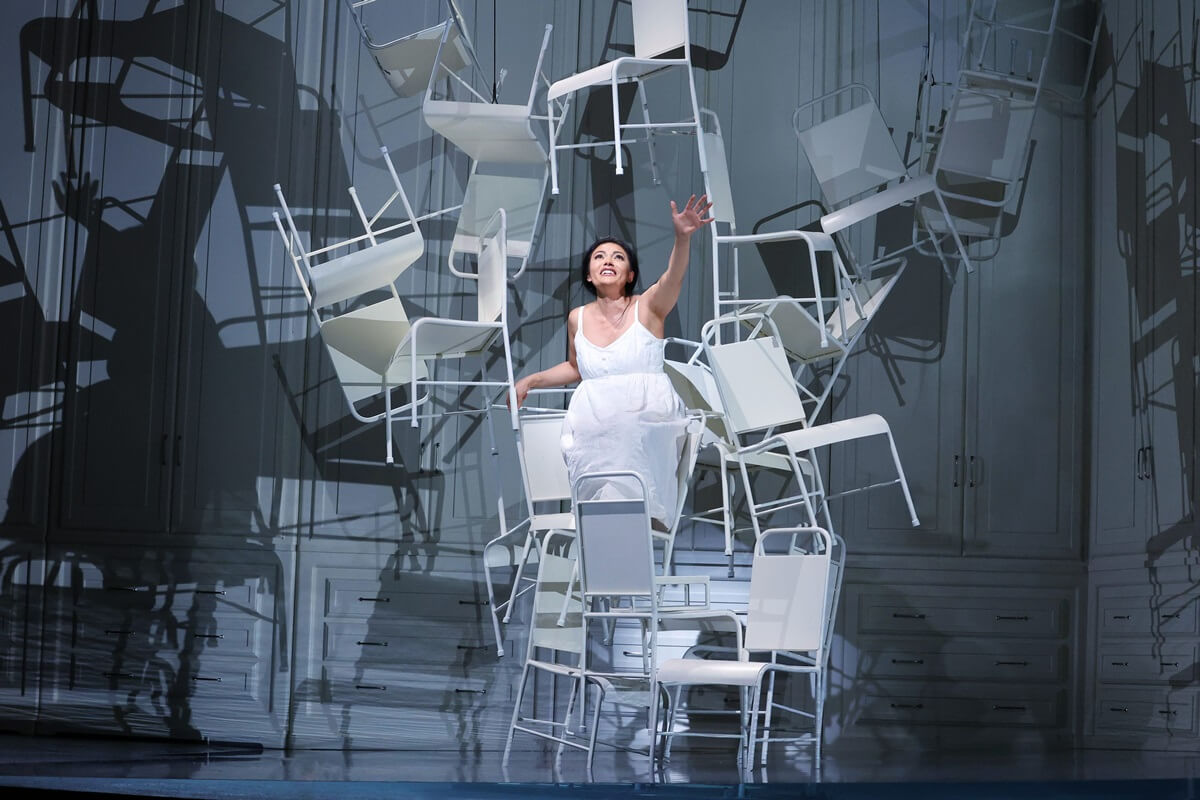
Rusalka
My final opera on this trip was another favourite, Dvorak’s Rusalka, an opera staged four seasons ago by the Canadian Opera Company starring the incomparable Sondra Radvanovsky. I was thrilled that SFO has engaged the equally marvelous Ailyn Perez in the title role. Vocally and dramatically, her performance was one of the highlights. She was ably partnered by American dramatic tenor Robert Watson as the Prince, singing with ringing tone, if occasionally a bit too stentorian for my taste.
At the risk of sounding like a broken record, I find the production by Sir David Pountney problematic, especially when I think of the gorgeously naturalistic Sir David McVicar production we recently enjoyed at the COC. The Pountney take on this piece is stylistically far from the misty lake where the water nymph Rusalka and her sisters inhabit. Here we are to believe that it’s a psychiatric ward in Victorian times, judging by the costumes. It’s basically a wall of white panels in Act One, vaguely suggestive of a medical institution. On one side is a jumbo of white chairs piled high and welded together every which way, next to a shallow pool of water. I give Ailyn Perez full marks for stretching out horizontally on the chairs in midair!
In Act Two, the white panels morph into glass display cases containing women in various poses, presumably signifying the past conquests of the Prince, the love of Rusalka. In Act Three, as the drama turns tragic, the display cases are chaotically tilted. What does one make of all this? If you are game for a revisionist approach to the Rusalka fairytale, you will find it amusing. If you aren’t, then at least there’s the divine music to keep you entertained, as led by the excellent Russian-born American conductor Lidiya Yankovskaya. The rest of the cast was also of a very high calibre. Mezzo Raehann Bryce-Davis was a powerful Jezibaba. Too bad her scenes seem to be staged to elicit laughter, and laugh they did Honestly, comic relief is quite at odds with such a tragic story. Also impressive was the Foreign Princess of dramatic soprano Mary Elizabeth Williams, whose big, somewhat edgy tone was appropriate for her character.
Final Thoughts
A few final observations. Compared to previous seasons, the calibre of music making this season is once again very high, but in terms of production, it is more uneven than usual. I approach each production with an open mind, but I have to say except for Orfeo, the others didn’t resonate with me. The other directorial approaches strayed too far into the conceptual realm. I spoke with a few audience members and several of them commented negatively about the productions.
Given that attendance has yet to recover to pre-pandemic levels, it’s worrisome that these shows will turn future audiences away. Let’s hope for the best. Next season has already been announced — La traviata, L’Elisir d’amore, Don Giovanni, The Righteous, and the happy return of Der Rosenkavalier, after an absence of 31 years. Tempting indeed!
For more information, see [HERE]. https://www.santafeopera.org/
#LUDWIGVAN
Get the daily arts news straight to your inbox.



